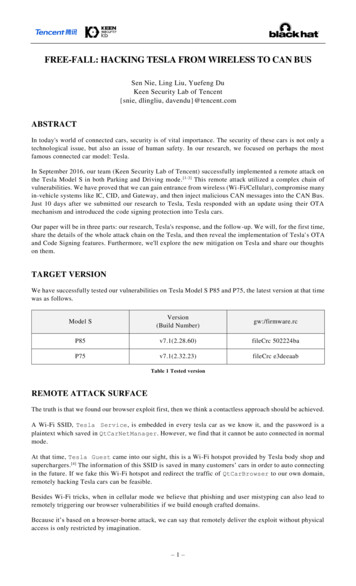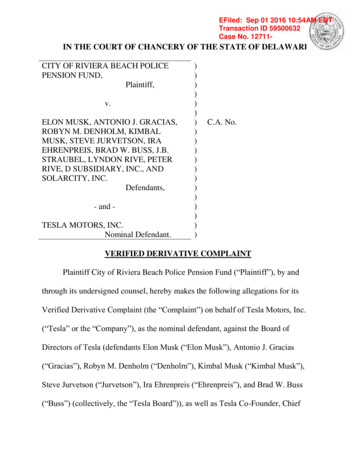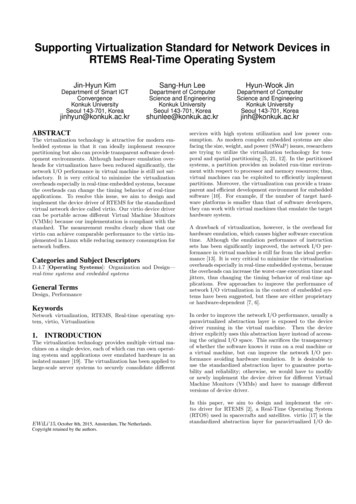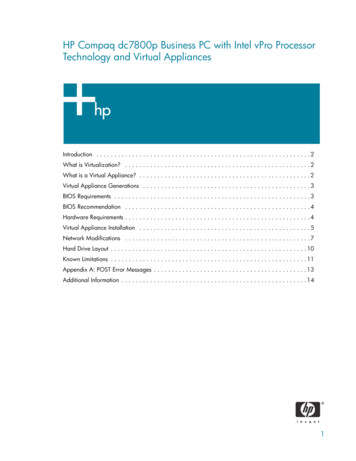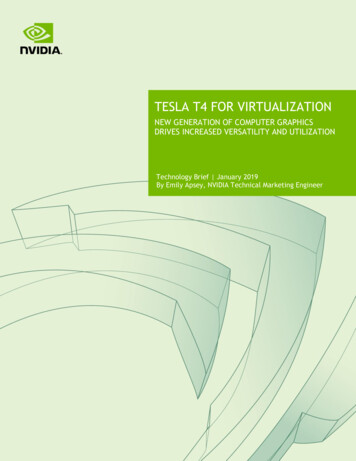
Transcription
TESLA T4 FOR VIRTUALIZATIONNEW GENERATION OF COMPUTER GRAPHICSDRIVES INCREASED VERSATILITY AND UTILIZATIONTechnology Brief January 2019By Emily Apsey, NVIDIA Technical Marketing Engineer
POWERING ANY VIRTUAL WORKLOADThe NVIDIA Tesla T4 GPU, based on the latest NVIDIA Turing architecture, is nowsupported for virtualized workloads with NVIDIA virtual GPU (vGPU) software. Using thesame NVIDIA graphics drivers that are deployed on non-virtualized systems, NVIDIAvGPU software provides Virtual Machines (VMs) with the same breakthroughperformance and versatility that the T4 offers to a physical environment.NVIDIA initially launched T4 at GTC Japan in the Fall of 2018 as an AI inferencingplatform for bare metal servers. When T4 was initially released, it was specificallydesigned to meet the needs of public and private cloud environments as their scalabilityrequirements continue to grow. Since then there has been rapid adoption and it wasrecently released on the Google Cloud Platform. The Tesla T4 is the most universal GPUto date -- capable of running any workload to drive greater data center efficiency. In abare metal environment, T4 accelerates diverse workloads including deep learningtraining and inferencing. Adding support for virtual desktops with NVIDIA GRID VirtualPC (GRID vPC) and NVIDIA Quadro Virtual Data Center Workstation (Quadro vDWS)software is the next level of workflow acceleration.The T4 has a low-profile, single slot form factor, roughly the size of a cell phone, anddraws a maximum of 70W power, so it requires no supplemental power connector. Thishighly efficient design allows NVIDIA vGPU customers to reduce their operating costsconsiderably and offers the flexibility to scale their vGPU deployment by installingadditional GPUs in a server, because two T4 GPUs can fit into the same space as a singleTesla M10 or M60 GPU, which could consume more than 3X the power.Figure 1 NVIDIA Tesla GPUs for virtualization workloads.The NVIDIA Tesla T4 leverages the Turing architecture – the biggest architectural leapforward in over a decade – enabling major advances in efficiency and performance.Some of the key features provided by the NVIDIA Turing architecture include TensorTechnology Brief: Tesla T4 for Virtualization (January 2019) 2
Cores for accelerating deep learning inference workflows as well as CUDA cores, TensorCores, and RT Cores for real-time ray tracing acceleration and batch rendering. It’s alsothe first GPU architecture to support GDDR6 memory, which provides improvedperformance and power efficiency versus the previous generation GDDR5.The Tesla T4 is an RTX-capable GPU, benefiting from all of the enhancements of the RTXplatform, including: Real-time ray tracing Accelerated batch rendering AI-enhanced denoising Photorealistic design with accurate shadows, reflections, and refractionsThe T4 is well-suited for a wide range of data center workloads including: Virtual Desktops for knowledge workers using modern productivity applications Virtual Workstations for scientists, engineers, and creative professionals Deep Learning Inferencing and TrainingHIGH-PERFORMANCE QUADRO VIRTUALWORKSTATIONSThe graphics performance of the NVIDIA Tesla T4 directly benefits virtual workstationsimplemented with NVIDIA Quadro vDWS software to run rendering and simulationworkloads. Users of high end applications, such as CATIA, SOLIDWORKS and ArcGIS Pro,are typically segmented as light, medium or heavy based on the type of workflowthey’re running and the size of the model/data they are working with. The T4 is a lowprofile, single slot card for light and medium users working with mid-to-large sizedmodels. NVIDIA T4 offers double the amount of framebuffer (16GB) versus the previousgeneration P4 (8GB) card, therefore users can work with bigger models within theirvirtual workstations. Benchmark results show that T4 with Quadro vDWS delivers 25%faster performance than P4 and offers almost twice the professional graphicsperformance of the NVIDIA Tesla M60.Technology Brief: Tesla T4 for Virtualization (January 2019) 3
Figure 2 Tesla T4 performance comparison with M60 and P4 based on SPECviewperf13.The Turing architecture of the Tesla T4 fuses real-time ray tracing, AI, simulation, andrasterization to fundamentally change computer graphics. Dedicated ray-tracingprocessors called RT Cores accelerate the computation of how light travels in 3Denvironments. Turing accelerates real-time ray tracing over the previous-generationNVIDIA Pascal architecture and can render final frames for film effects faster thanCPUs. The new Tensor Cores, processors that accelerate deep learning training andinference, accelerate AI-enhanced graphics features—such as denoising, resolutionscaling, and video re-timing—creating applications with powerful new capabilities.Figure 3 Illustrating the benefits of real-time rendering with RTX technology.DEEP LEARNING INFERENCINGThe NVIDIA T4 with the Turing architecture sets a new bar for power efficiency andperformance for deep learning and AI. Its multi-precision tensor cores combined withTechnology Brief: Tesla T4 for Virtualization (January 2019) 4
accelerated containerized software stacks from NVIDIA GPU Cloud (NGC) deliversrevolutionary performance.As we are racing towards a future where every customer inquiry, every product andservice will be touched and improved by AI, NVIDIA vGPU is bringing Deep Learninginferencing and training workflows to virtual machines. Quadro vDWS users can nowexecute inferencing workloads within their VDI sessions by accessing NGC containers.NGC integrates GPU-optimized deep learning frameworks, runtimes, libraries and eventhe OS into a ready-to-run container, available at no charge. NGC simplifies andstandardizes deployment, making it easier and quicker for data scientists to build, trainand deploy AI models. Accessing NGC containers within a VM offers even moreportability and security to virtual users for classroom environments and virtual labs.Test results show that Quadro vDWS users leveraging Tesla T4 can run deep learninginferencing workloads 25X faster than with CPU-only VMs.Figure 3 Run video inferencing workloads up to 25X faster with Tesla T4 and QuadrovDWS versus a CPU-only VM.VIRTUAL DESKTOPS FOR KNOWLEDGE WORKERSBenchmark test results show that the T4 is a universal GPU which can run a variety ofworkloads, including virtual desktops for knowledge workers accessing modernproductivity applications. Modern productivity applications, high resolution and multiplemonitors, and Windows 10 continue to require more graphics and with NVIDIA GRID vPCsoftware, combined with NVIDIA Tesla GPUs, users can achieve a native-PC experiencein a virtualized environment. While the Tesla M10 GPU, combined with GRID software,Technology Brief: Tesla T4 for Virtualization (January 2019) 5
remains the ideal solution to provide optimal user density, TCO and performance forknowledge workers in a VDI environment, the versatility of the T4 makes it an attractivesolution as well.The M10 was announced in Spring of 2016 and offers the best user density andperformance option for GRID vPC customers. The M10 is a 32GB dual slot card whichdraws up to 225W of power, therefore requires a supplemental power connector. TheTesla T4 is a low profile, 16GB single slot card, which draws 70W maximum and does notrequire a supplemental power connector.Two NVIDIA T4 GPUs provide 32GB of framebuffer and support the same user density asa single Tesla M10 with 32GB of framebuffer, but with lower power consumption.While the M10 provides the best value for knowledge worker deployments, selectingthe T4 for this use case brings the unique benefits of the Turing architecture. Thisenables IT to maximize data center resources by running virtual desktops in addition tovirtual workstations, deep learning inferencing, rendering and other graphics andcompute intensive workloads -- all leveraging the same data center infrastructure. Thisability to run mixed workloads can increase user productivity, maximize utilization, andreduce costs in the data center. Additional T4 technology enhancements includesupport for VP9 decode, which is often used for video playback, and H.265 (HEVC) 4:4:4encode/decode.SUMMARYThe flexible design of the Tesla T4 makes it well suited for any data center workload enabling IT to leverage it for multiple use cases and maximize efficiency and utilization.It is perfectly aligned for vGPU implementations - delivering a native-PC experience forvirtualized productivity applications, untethering architects, engineers and designersfrom their desks, and enabling deep learning inferencing workloads from anywhere, onany device. This universal GPU can be deployed across industry-standard servers toprovide graphics and compute acceleration across any workload and future-proof thedata center. Its dense, low power form factor can improve data center operatingexpenses while improving performance and efficiency and scales easily as compute andgraphics needs grow. 2019 NVIDIA Corporation. All rights reserved. NVIDIA, NVIDIA Quadro, Pascal, Turing, Volta, GRID, theNVIDIA logo, and Tesla are trademarks and/or registered trademarks of NVIDIA Corporation. All companyand product names are trademarks or registered trademarks of the respective owners with which theyare associated. JAN2019Technology Brief: Tesla T4 for Virtualization (January 2019) 6
Technology Brief: Tesla T4 for Virtualization (January 2019) 3 Cores for accelerating deep learning inference workflows as well as CUDA cores, Tensor Cores, and RT Cores for real-time ray tracing acceleration and batch rendering. It's also the first GPU architecture to support GDDR6 memory, which provides improved


